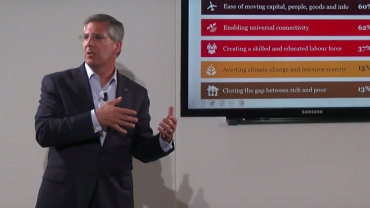
By Bob Moritz, Global Chairman, PwC
Around the world, the workplace gender gap is an area in need of immediate and serious attention.
To be sure, we are making progress: the 2016 World Economic Forum’s Gender Gap report found that based on current trends, the global gender gap can be closed in 83 years. While it’s reassuring to hear that a baby girl born today will face less gender discrimination, we can surely drive change more quickly.
I was honored to participate on a panel yesterday with a group of people who are well-positioned to accelerate the timeline for gender parity. IMF’s Christine LaGarde, entrepreneur Cynthia Castro, Panama’s vice president Isabel Saint Malo, and filmmaker Sharmeen Obaid-Chinoy are all leaders who are determined to close the gender gap for all women in the near future.
Our discussion was focused on the specific actions we all must take to speed up gender parity. From the issue of diversity on executive boards to income equality to quotas and established processes, we agreed that the responsibility for gender equality belongs to all us — not just with women. The second point where we all came together was that progress must be pushed on all fronts of society.
This is a problem we are committed to solving at PwC. Based on our efforts so far, here are my top six strategies for disrupting institutional inertia around gender roles.
Challenge negative stereotypes. We all can do our part by highlighting outdated stereotypes and reinforcing the realities of the modern workforce. “Stay-at-home dad,” for example, should raise no eyebrows. We can also help dismantle stereotypes with facts. For example, “men are the primary earner,” is increasingly outmoded in a world where 66% of female millennials in a relationship earn equal to or more than their partner or spouse. Indeed, fathers who take time off to help look after their families are better leaders, as one participant pointed out.
Crunch the numbers; use the tech. At PwC, we are working towards transforming our diversity and inclusion strategy using the data. For example, we had historically presumed we had fewer women in senior positions because women opted out of their careers to focus on their families. After rigorously analyzing the data, however, we learned that women leave PwC more than men only at our most junior grades — a level at which very few women are starting a family. But we were replacing departing men and women with predominantly male experienced hires. As a result, diversifying our experienced hires is now critical to our diversity and inclusion strategy. Keeping on top of the numbers annually, and in some cases quarterly, shows us where our focus and resources are needed. Technology can now help disrupt the status quo of gender roles.
Implement critical interventions at all stages of the talent lifecycle. Inclusive talent processes are essential, but without interventions to respond to barriers, we will be unable to solve the pipeline shortages. Leaders in the corporate workplace have to take responsibility, Lagarde pointed out, to ensure that the aim of gender equality is consistently enforced.
Enhance awareness of unconscious bias. Just having a male name is more likely to get you the job. If you are a mother, your chances of getting the job are reduced by 70%. These biases can be uprooted through blindspot training and education about self-awareness when making hiring, promotion, and job assignment decisions. But it’s not a one-time effort. We repeat and repeat and repeat the message that bias is universal and actionable.
Bring men into the conversation. Most men think we’re operating in a meritocracy — and when we have that ‘aha’ moment that no one is completely unbiased — then people become willing to change. I’m very proud that PwC was one of the first organizations to sign on as a Corporate Impact 10x10x10 Champion for the UN’s HeForShe movement. HeForShe engages men as champions of equality on a greater scale than ever before and educating them on why this matters and how gender equality benefits everyone.
Increase focus on inclusive behaviour. Inclusive talent management is about having the skills to recognise who is the best talent for any given opportunity and moving away from the well-trodden path of mentoring and promoting people who look/think/act like you.
Gender equality is not a zero sum game — it will bring better opportunities to men and women alike (including at leadership levels), will benefit the economy, and and will help all of us work better across various differences. Eradicating gender-based pigeonholes and enabling both genders to contribute equally in business and their personal lives are win-wins. The sooner we get there, the better.
















